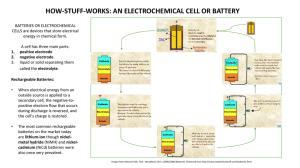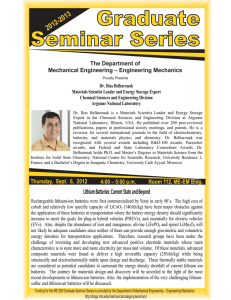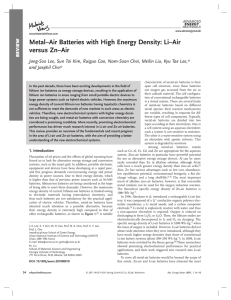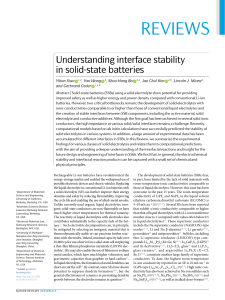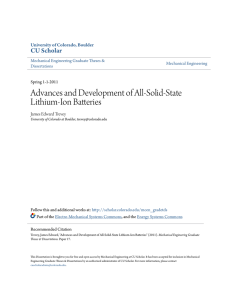Mechanical and electrochemical response of all-solid
advertisement
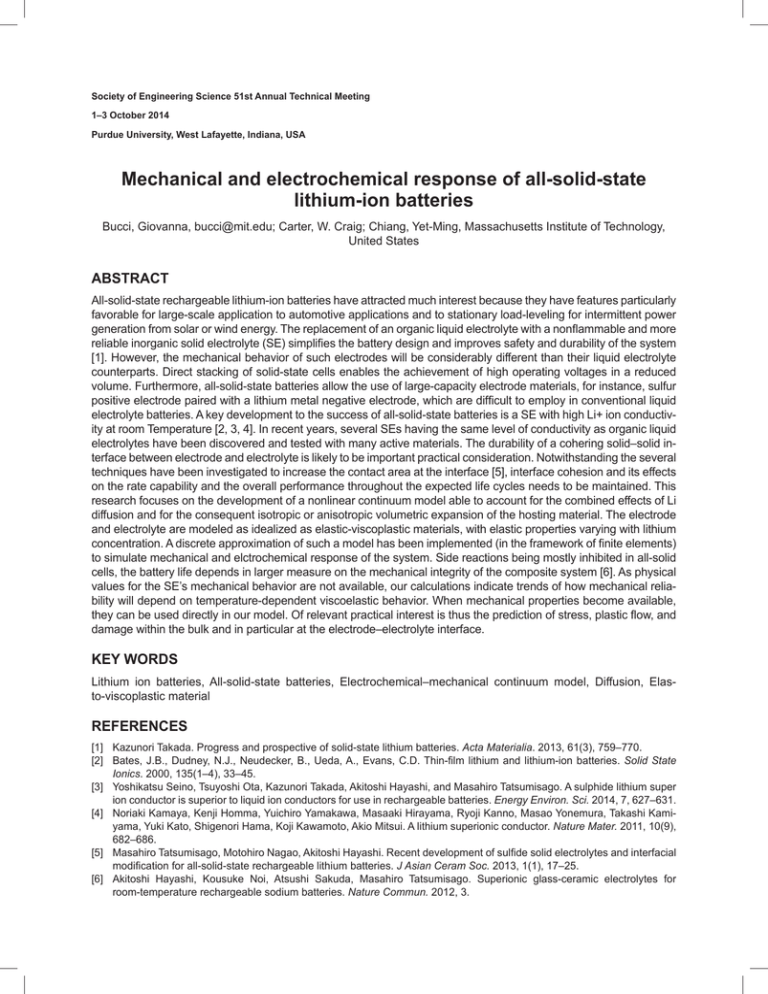
Society of Engineering Science 51st Annual Technical Meeting 1–3 October 2014 Purdue University, West Lafayette, Indiana, USA Mechanical and electrochemical response of all-solid-state lithium-ion batteries Bucci, Giovanna, bucci@mit.edu; Carter, W. Craig; Chiang, Yet-Ming, Massachusetts Institute of Technology, United States ABSTRACT All-solid-state rechargeable lithium-ion batteries have attracted much interest because they have features particularly favorable for large-scale application to automotive applications and to stationary load-leveling for intermittent power generation from solar or wind energy. The replacement of an organic liquid electrolyte with a nonflammable and more reliable inorganic solid electrolyte (SE) simplifies the battery design and improves safety and durability of the system [1]. However, the mechanical behavior of such electrodes will be considerably different than their liquid electrolyte counterparts. Direct stacking of solid-state cells enables the achievement of high operating voltages in a reduced volume. Furthermore, all-solid-state batteries allow the use of large-capacity electrode materials, for instance, sulfur positive electrode paired with a lithium metal negative electrode, which are difficult to employ in conventional liquid electrolyte batteries. A key development to the success of all-solid-state batteries is a SE with high Li+ ion conductivity at room Temperature [2, 3, 4]. In recent years, several SEs having the same level of conductivity as organic liquid electrolytes have been discovered and tested with many active materials. The durability of a cohering solid–solid interface between electrode and electrolyte is likely to be important practical consideration. Notwithstanding the several techniques have been investigated to increase the contact area at the interface [5], interface cohesion and its effects on the rate capability and the overall performance throughout the expected life cycles needs to be maintained. This research focuses on the development of a nonlinear continuum model able to account for the combined effects of Li diffusion and for the consequent isotropic or anisotropic volumetric expansion of the hosting material. The electrode and electrolyte are modeled as idealized as elastic-viscoplastic materials, with elastic properties varying with lithium concentration. A discrete approximation of such a model has been implemented (in the framework of finite elements) to simulate mechanical and elctrochemical response of the system. Side reactions being mostly inhibited in all-solid cells, the battery life depends in larger measure on the mechanical integrity of the composite system [6]. As physical values for the SE’s mechanical behavior are not available, our calculations indicate trends of how mechanical reliability will depend on temperature-dependent viscoelastic behavior. When mechanical properties become available, they can be used directly in our model. Of relevant practical interest is thus the prediction of stress, plastic flow, and damage within the bulk and in particular at the electrode–electrolyte interface. KEY WORDS Lithium ion batteries, All-solid-state batteries, Electrochemical–mechanical continuum model, Diffusion, Elasto-viscoplastic material REFERENCES [1] Kazunori Takada. Progress and prospective of solid-state lithium batteries. Acta Materialia. 2013, 61(3), 759–770. [2] Bates, J.B., Dudney, N.J., Neudecker, B., Ueda, A., Evans, C.D. Thin-film lithium and lithium-ion batteries. Solid State Ionics. 2000, 135(1–4), 33–45. [3] Yoshikatsu Seino, Tsuyoshi Ota, Kazunori Takada, Akitoshi Hayashi, and Masahiro Tatsumisago. A sulphide lithium super ion conductor is superior to liquid ion conductors for use in rechargeable batteries. Energy Environ. Sci. 2014, 7, 627–631. [4] Noriaki Kamaya, Kenji Homma, Yuichiro Yamakawa, Masaaki Hirayama, Ryoji Kanno, Masao Yonemura, Takashi Kamiyama, Yuki Kato, Shigenori Hama, Koji Kawamoto, Akio Mitsui. A lithium superionic conductor. Nature Mater. 2011, 10(9), 682–686. [5] Masahiro Tatsumisago, Motohiro Nagao, Akitoshi Hayashi. Recent development of sulfide solid electrolytes and interfacial modification for all-solid-state rechargeable lithium batteries. J Asian Ceram Soc. 2013, 1(1), 17–25. [6] Akitoshi Hayashi, Kousuke Noi, Atsushi Sakuda, Masahiro Tatsumisago. Superionic glass-ceramic electrolytes for room-temperature rechargeable sodium batteries. Nature Commun. 2012, 3.
